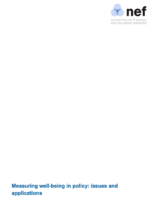Measuring wellbeing in policy
Issues and application
21 October 2008
We consider approaches to measuring well-being from the perspective of their utility for policy-making.
We focus on subjective indicators and consider a number of relevant issues, including: philosophical debate around the role of government in promoting well-being; using well-being indicators as leading or lagging indicators; different approaches to well-being across the life course; and technical limitations of subjective indicators. Our report concludes with a summary of recent exploratory work on well-being for local government.
Well-being in current policy
Under a reasonably broad definition, well-being has been the subject of considerable recent discussion in policy circles. Examples include:
- The Local Government Act (2000) requiring each local authority to prepare a Community Strategy, outlining how it would promote economic, social and environmental well-being.
- Every Child Matters – a national framework for coordinating and orienting the provision of children’s services.
- Opportunity Age – a national strategy for improving older people’s well-being.
- Securing the Future – the UK’s sustainable development strategy that has led to several research reviews on the concept of well-being and its relation to sustainability.
Dolan et al. reviewed a range of theoretical approaches to well-being drawn from different disciplines and outlined a taxonomy of well-being models in terms of their underlying conceptual approach: 1) preference satisfaction; 2) basic needs; 3) flourishing; 4) hedonic; and 5) evaluative. Whilst it is tempting to see these different approaches as competing with one another, we argue that it is more helpful for policy-makers to view well-being itself as a dynamic process, in which a person’s external circumstances interact with their psychological resources to satisfy – to a greater or lesser extent – their psychological needs and to give rise to positive feelings of happiness and satisfaction.
Applications of well-being measurement in policy
- Political acceptability of well-being measures. According to some traditions of thought – i.e. the liberal tradition – the ‘happiness’ of individuals is not the business of state and, hence, government should not be concerned with measuring well-being. Contemporary worries about ‘paternalism’, the ‘nanny state’ and a ‘big brother society’ can be seen as manifestations of this debate. Citizens of the UK, however, expect government to promote their interests; for instance, there is consistent support for the welfare state, the NHS and for government interventions to protect the environment and to relieve poverty. Hence, it is argued that using well-being indicators in policy is consistent with these expectations.
- Means and ends/leads and lags. For any given outcome, it is usually possible to distinguish between the means through which the outcome is achieved, and the actual end result. It is intuitive to think of well-being only as an end or outcome of policy, but in some contexts is may be appropriate to think of it as a means or a driver of other desirable/policy-relevant outcomes.
- Applicability of different approaches across the life course. Most theoretical models of well-being are intended to apply generally to people of all ages. As there is no one ‘correct’ model of well-being, however, the question arises as to whether different elements of well-being are differentially more or less important at different stages of life. To date, there is little evidence to guide decisions about which kind of model is appropriate for which age group.
Technical considerations
- Boundedness. Most subjective well-being indicators require people to evaluate some aspect of their experience on a scale with an upper and a lower limit. By definition, such scales impose a minimum and maximum value on whatever dimension is being evaluated. This can be a problem for tracking changes over time. For many policy purposes, however, it does not pose a significant limitation on the use of subjective indicators.
- Set-points and adaptation. Psychologists have suggested that individuals have a ‘set-point’ for subjective well-being to which they will tend to default, even as their life circumstances may vary and temporarily push their well-being up or down. ‘Adaptation’ to changes in circumstances is not always total, but the effect is powerful enough that caution must be exercised when considering changes in well-being over time.
- Status effects. A person’s relative status – inferred through socio-economic variables such as income – can have a notable impact on his/her subjective well-being. Currently, not enough is known about whom people compare themselves with as to enable status effects to be easily controlled for.
SWOT analysis
NEF hosted a workshop with policy-makers from across government. The core of this workshop was a SWOT –Strengths, Weaknesses, Opportunities, Threats – analysis of issues surrounding the use of well-being indicators in policy. In the negative side, an important issue was clarity, in relation both to the distinction between well-being and happiness, and also to measurement and communication. On the positive side, it was noted that well-being is an explicit part of policy discourse across a number of different areas, and also that it is a good fit with several emerging agendas that are not currently using the language of well-being.
Choosing indicators for policy
Despite considerable and rapidly growing interest, indicators of subjective well-being have not been widely used in policy. Recent work by NEF has begun to develop a framework to help local authorities approach the issue of choosing an appropriate well-being indicator. It outlines three broad approaches to well-being measurement that are of relevance to policy-makers:
- Universal. Headline information about general well-being at a population level that can be used as a basis for more detailed exploration.
- Domain. Information about understanding how people feel in relation to different aspects or dimensions of their lives; for example, health, community safety, economic circumstances.
- Targeted. Rich information about the psychological well-being of people identified as vulnerable or in need of specialised services.
Topics Wellbeing







